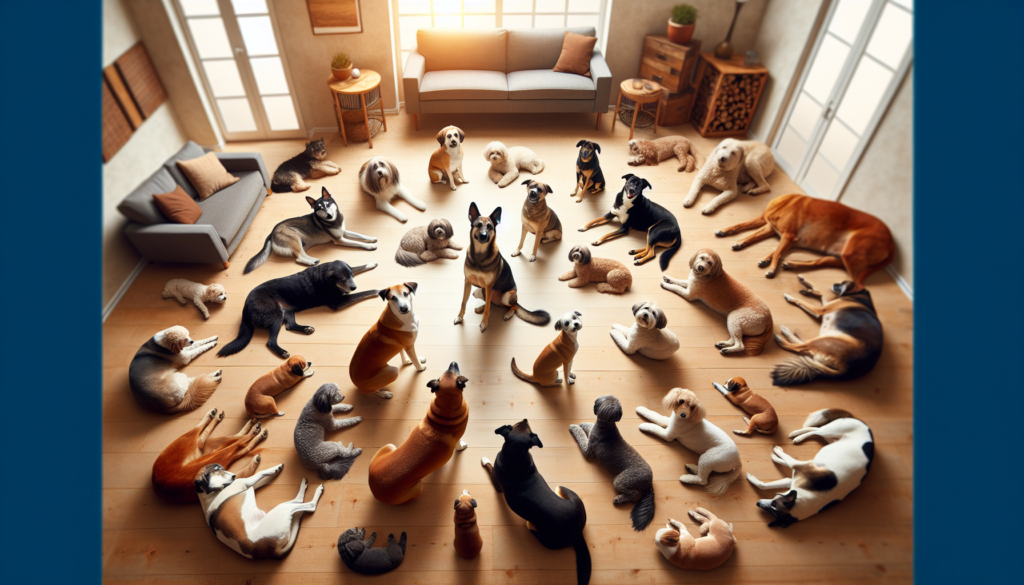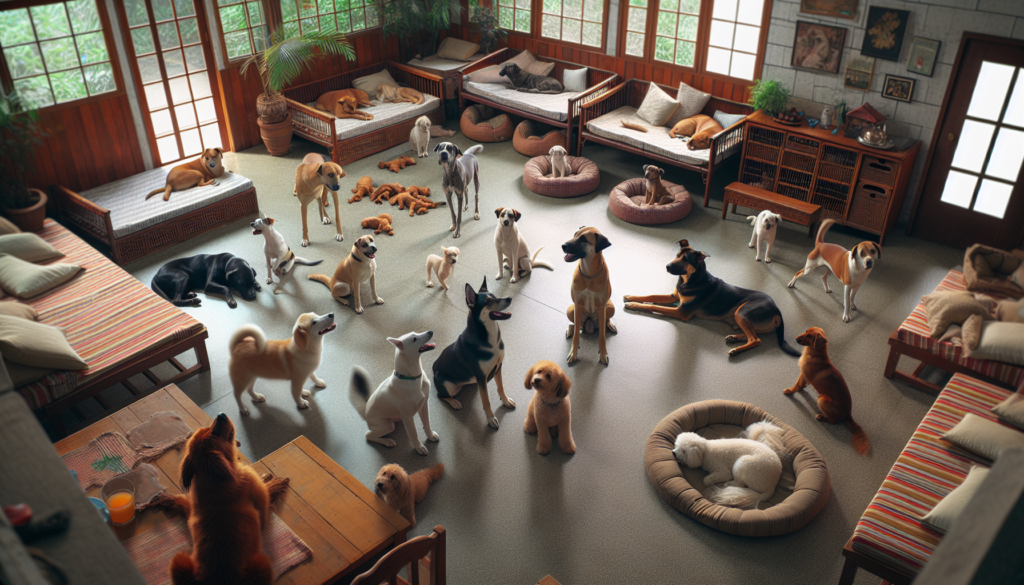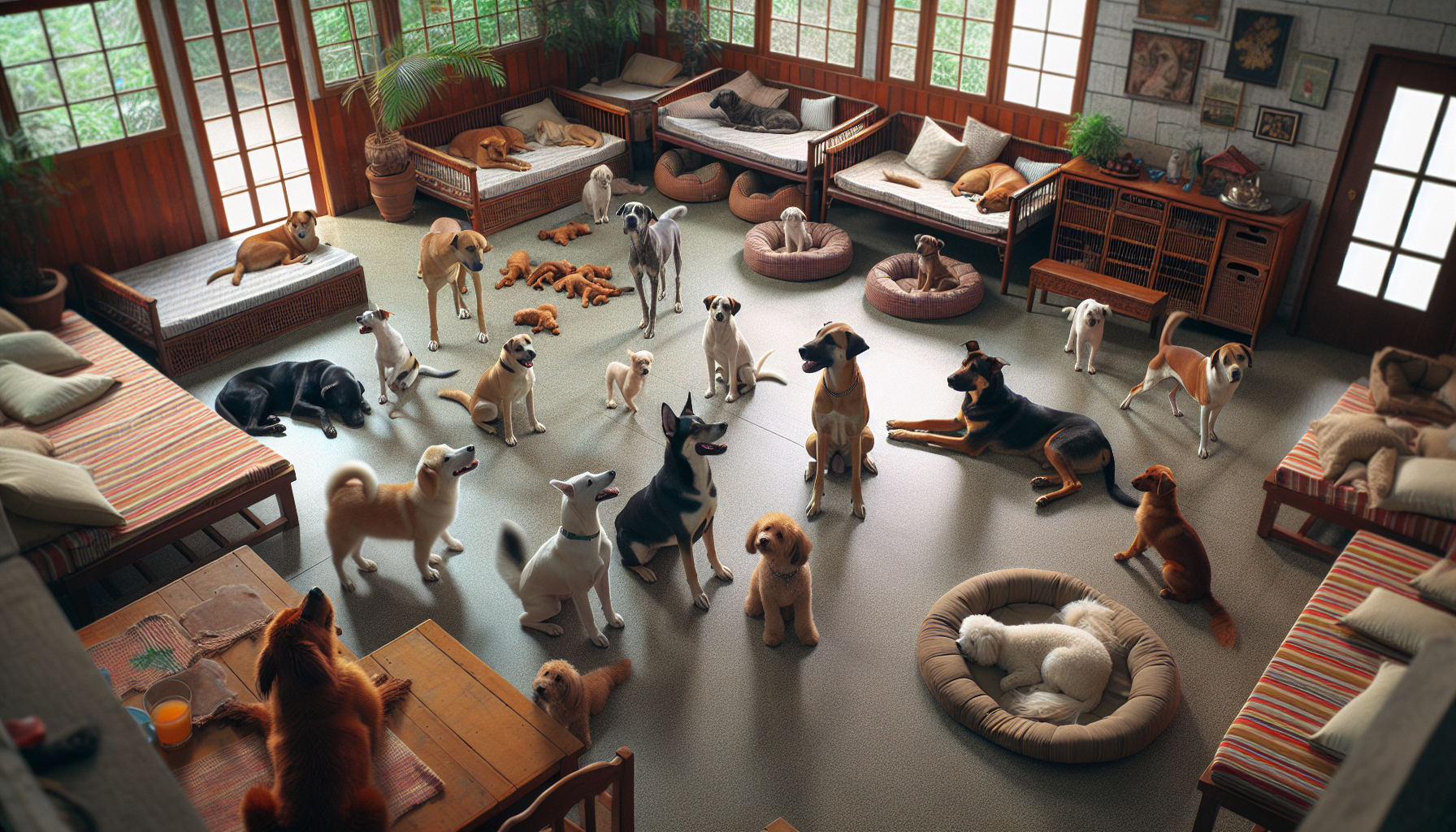Living with multiple dogs in one household can be rewarding, but it also comes with its own set of challenges. From establishing a harmonious pack dynamic to ensuring everyone gets enough attention and exercise, managing a multi-dog household requires careful planning and consideration. In this article, you will explore practical strategies and tips that can help you create a happy and peaceful environment for all your furry companions. Whether you’re a seasoned multi-dog owner or are considering adding a second (or third!) dog to your family, these strategies will equip you with the knowledge and tools to navigate the complexities of cohabiting with multiple canines.

Setting Up the Environment
Having a well-planned and organized environment is crucial when it comes to managing a multi-dog household. One of the first steps is to provide separate feeding areas for each dog. This helps prevent competition and potential tension during mealtimes. Whether it’s different rooms or designated feeding stations, make sure each dog has its own space to eat peacefully.
In addition to separate feeding areas, it’s important to provide sufficient resources for each dog. This includes having multiple water bowls, bedding, toys, and even separate food bowls. By ensuring that each dog has its own set of resources, you minimize the likelihood of fights or conflicts arising from sharing limited resources.
Creating individual spaces for each dog is another key aspect of setting up the environment. This can be accomplished by providing separate crates, beds, or designated areas within the house. These individual spaces serve as safe havens for the dogs, allowing them to have their own personal retreats whenever they need some downtime or alone time.
Using baby gates and barriers can also be helpful in managing a multi-dog household. These tools allow you to create boundaries and restrict access to certain areas of the house. This can be particularly useful during meal times, when you want to separate the dogs, or when introducing them to a new environment.
Lastly, establishing play and rest areas is essential for ensuring that each dog gets the physical exercise and mental stimulation they need. Set up designated play areas, both indoors and outdoors, where the dogs can engage in interactive activities and play together. Additionally, make sure there are quiet and comfortable spaces for the dogs to rest and recharge when necessary.
Establishing a Routine
A well-established routine is beneficial for both dogs and their owners in a multi-dog household. Setting consistent meal times helps create structure and ensures that each dog receives its fair share of food. This also helps prevent potential conflicts that can arise from food-related issues.
Designating a walking schedule is another important aspect of establishing a routine. Dogs thrive on regular exercise, so having a set time for walks ensures that each dog receives the daily exercise they need. Additionally, walking the dogs individually can help minimize any potential conflicts or competition during walks.
Establishing training sessions is not only beneficial for individual dog development but also for maintaining harmony within the household. Dogs should be trained separately to avoid distractions and provide focused attention. By dedicating time to train each dog individually, you will not only strengthen the bond between you and your dogs but also encourage their individual growth and development.
Creating a playtime routine is equally important in a multi-dog household. Having dedicated play sessions allows each dog to engage in fun activities, interact with their human family members, and socialize with each other. Remember to supervise the playtime and ensure that it remains positive and safe for all the dogs involved.
Introducing New Dogs
Bringing a new dog into a multi-dog household requires careful planning and gradual introduction. Starting with neutral territory minimizes territorial behavior and reduces the chances of immediate conflicts. Choosing a neutral location, such as a park or a friend’s backyard, allows the dogs to meet each other in a neutral and non-threatening environment.
Gradual introduction is key when introducing new dogs. Initially, it is best to keep the dogs separated by using baby gates or crates. This allows them to become familiar with each other’s scents and presence without direct interaction. Slowly increase their exposure to each other by allowing short, controlled interactions while closely monitoring their behavior.
Supervised interactions are crucial during the initial stages of introducing new dogs. Keep a close eye on the dogs’ body language and behavior to ensure that the interactions remain positive and stress-free. If any signs of aggression or tension arise, separate the dogs and try again at a later time.
Positive reinforcement is essential when introducing new dogs. Reward calm and friendly behavior with treats, praise, or toys. This helps create positive associations between the dogs and encourages them to engage in friendly interactions. Gradually increase the duration and intensity of the interactions as the dogs become more comfortable with each other.
Ensuring Balanced Attention
When living with multiple dogs, it’s important to provide each dog with quality time and attention. Spending one-on-one time with each dog strengthens the bond between you and your furry companions. Whether it’s going on a solo walk or simply sitting together and cuddling, make sure to dedicate individual time to each dog.
Rotate affection and play among your dogs to avoid favoritism. Each dog should have equal opportunities to receive attention, playtime, and affection from their human family members. By rotating these experiences, you ensure that no dog feels left out or neglected. This also encourages the dogs to interact with each other and prevents overdependence on any one individual.
Avoiding favoritism is crucial when managing a multi-dog household. Show equal love and attention to all your dogs to maintain a harmonious environment. Treat each dog as an individual with their own unique needs and build a strong and loving relationship with each of them.

Dealing with Sibling Rivalry
Sibling rivalry can sometimes occur in multi-dog households, and it’s important to address it appropriately. Identifying trigger points, such as food, toys, or attention, can help you better understand the source of the rivalry. Once you’ve identified these triggers, you can work towards managing and minimizing any potential conflicts.
Resource guarding is a common behavior in multi-dog households, where one dog may become possessive over certain resources. It’s important to manage this behavior by ensuring that each dog has access to the necessary resources without feeling the need to guard them. This may involve feeding the dogs separately or providing multiple toys and items to avoid competition over limited resources.
If sibling rivalry persists and becomes problematic, it’s important to seek professional help. A professional dog trainer or behaviorist can provide guidance and tailor a training plan specific to your multi-dog household’s needs. They can help address and modify any negative behaviors, ensuring a safe and harmonious environment for all your furry friends.
Strengthening Bond Between Dogs
Building a strong bond between the dogs in a multi-dog household is beneficial for their overall well-being and the harmony of the household. Group training sessions are a great way to foster cooperation and teamwork among the dogs. Engage in training activities that require all the dogs to work together, such as agility exercises or puzzle-solving tasks.
Shared engaging activities further strengthen the bond between the dogs. Play games such as fetch or tug-of-war that encourage interaction and cooperation. Interactive toys and treat-dispensing puzzles can also provide mental stimulation and engage the dogs in joint activities.
Joint walks and adventures are not only great exercise for the dogs but also an opportunity for them to bond and experience new environments together. Exploring new places, meeting other dogs, and encountering various stimuli as a group can help strengthen the bond between the dogs and enhance their social skills.
Addressing Behavioral Issues
Behavioral issues, such as aggression, separation anxiety, and excessive barking, can arise in multi-dog households. It’s important to identify and address these issues promptly to maintain a harmonious living environment.
Identifying and addressing aggression requires professional help. Aggression between dogs can escalate quickly and pose a risk to the safety of both humans and dogs. A professional dog trainer or behaviorist can assess the situation, provide guidance on managing the aggression, and create a behavior modification plan tailored to the specific needs of your dogs.
Separation anxiety can be challenging to manage in a multi-dog household. Each dog may have different levels of anxiety when separated from their human family members or other dogs. It’s important to address separation anxiety through gradual desensitization and counter-conditioning techniques. Providing each dog with their own safe space and engaging them in mentally stimulating activities can also help alleviate separation anxiety.
Excessive barking can be disruptive and lead to tension in a multi-dog household. Identifying the underlying cause of the barking is crucial in addressing this issue. Whether it’s boredom, anxiety, or alerting behavior, implementing appropriate training techniques, mental stimulation, and positive reinforcement can help minimize excessive barking.
Training and Socialization
Training and socialization are crucial for every dog, and it becomes even more important in a multi-dog household. Train the basic commands, such as “sit,” “stay,” and “come,” individually with each dog. This ensures that each dog understands and responds to the commands reliably, reducing the likelihood of confusion or competition during training sessions.
Practicing commands in group settings further strengthens their response and promotes cooperation among the dogs. Engage in training sessions where all the dogs are present and reinforce their behavior with treats and positive reinforcement. This not only helps with general obedience but also fosters a sense of unity and teamwork among the dogs.
Attending obedience classes can be highly beneficial, especially for multi-dog households. These classes provide structured training and socialization opportunities in a controlled environment. They allow the dogs to learn to work alongside other dogs and people, refining their social skills and reinforcing good behaviors.
Promoting positive interactions with other dogs is essential in a multi-dog household. Provide opportunities for your dogs to interact with other dogs through supervised playdates, visits to dog parks, or joining dog-friendly social groups. Proper socialization helps prevent behavioral issues and ensures that your dogs can peacefully interact with other dogs outside of their immediate pack.
Maintaining Health and Hygiene
Ensuring the health and hygiene of each dog in a multi-dog household is vital for their overall well-being. Regular vet check-ups are essential to monitor each dog’s health, address any underlying issues, and ensure they are up-to-date on vaccinations and preventive treatments.
Individual grooming sessions are important to maintain the cleanliness and comfort of each dog. Grooming needs may vary among the dogs, but it’s crucial to regularly brush their coats, clean their ears, trim their nails, and attend to any specific grooming requirements they may have. This individual attention during grooming also provides an opportunity for you to bond with each dog.
Controlling fleas and parasites is crucial in a multi-dog household, as they can quickly spread from one dog to another. Implement a regular flea prevention and control routine, which may include topical treatments, oral medications, and regular grooming to ensure that all dogs in your household are protected.
Resolving Territory Issues
Territory issues can arise in multi-dog households, especially when it comes to resource hoarding or competing for space. It’s important to address these issues to maintain a harmonious living environment for all the dogs.
Avoid resource hoarding by providing ample resources for each dog. This includes separate food and water bowls, toys, and bedding. By ensuring that each dog has its own set of resources, you minimize the need to guard or compete for limited resources, reducing territorial behavior.
Designating spaces for each dog can also help resolve territory issues. Provide separate crates, beds, or designated areas where each dog can retreat to when they need space or downtime. This allows them to have their own personal territory within the household and reduces the likelihood of conflicts related to territoriality.
Consider the design of your outdoor space when managing territorial issues. Creating separate areas or fencing off specific sections can help distribute the territory and prevent territorial disputes between the dogs. Providing each dog with their own space to explore and relax in the yard can help minimize territorial behaviors.
In conclusion, managing a multi-dog household requires careful planning and consideration. By setting up the environment to provide separate feeding areas, sufficient resources, and individual spaces, you create a harmonious living environment for all the dogs. Establishing a routine that includes consistent mealtimes, designated walking schedules, and training sessions ensures they receive the necessary structure and attention they need. Introducing new dogs gradually, balancing attention, addressing sibling rivalry, and strengthening the bond between dogs are key strategies to prevent conflicts and promote a peaceful coexistence. Properly addressing behavioral issues, training, and socializing each dog individually and maintaining their health and hygiene are important in managing a multi-dog household successfully. Lastly, resolving territory issues by avoiding resource hoarding, designating spaces, and considering outdoor space design helps maintain a harmonious living environment for all the dogs in your household. With these strategies in place, you can create a loving and balanced atmosphere where all your dogs can thrive and coexist happily.

